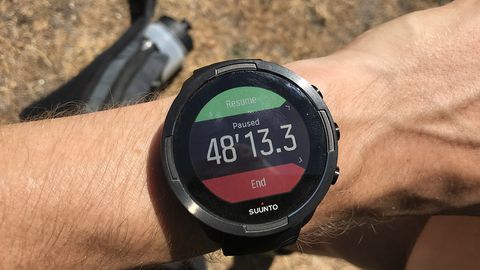Why you can trust TechRadar
Battery life
- Up to 120 hours of battery life
- Various configurable battery modes
- Will intelligently alert you ahead of workouts if it needs a charge
We wouldn’t usually dive into a review with battery life, but as we’ve mentioned the killer feature on the Suunto 9 is the remarkable staying power. What you get here isn’t just a watch that lasts a long time though, it’s smarter than that.
There are several clever ways the new intelligent battery system helps beat battery drain without sacrificing tracking accuracy for pace, distance, speed and those other GPS-driven stats.
For a kick off, before you begin a session, on the Start screen you’re given a battery life estimate in hours based on your current mode. With a simple tap of the top right button you can toggle between power modes, making it easy to choose a setting that will last as long as your planned activity.
There are three predefined battery modes – Performance, Endurance and Ultra – and the Suunto 9 tweaks the watch settings and tools to give you more juice.
In Performance mode you get up to 25 hours with everything – barring the touchscreen which disables in all sports modes – remaining on. This includes default screen brightness, optical heart rate or chest-strap HR, vibration alerts and notifications switched on, along with the GPS pinging every second.
Flick to Endurance mode and the GPS readings drop to intervals of 60 seconds, wrist heart rate tracking is disabled and the screen brightness dims to 20%. Everything else stays the same and this extends the battery life to up to 40 hours.
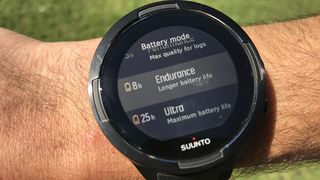
Finally there’s Ultra mode where the GPS reading falls to 120 seconds, heart rate is off, vibration alerts are shut down and the screen dims to 10% and hibernates after 10 seconds. The watch basically shuts down all functions that aren’t crucial to tracking your activity, but theoretically extends battery life to 120 hours.
All of this is done while limiting the loss of accuracy thanks to what Suunto calls FusedTrack. The watch combines data from the compass, gyroscope and accelerometer to fill in the gaps in information between the GPS readings. This is for running and ultra running only as there’s insufficient accelerometer activity in cycling to plug the necessary gaps.
One of the things that makes Suunto popular with adventure types is the ability to customize the watch to very specific needs and you can do that with battery too. It’s possible to create your own custom battery settings for each sport mode, for example you can have heart rate on in Ultra and Endurance mode if that’s desirable.
Once you’re into an activity, the Suunto 9 can also estimate how much battery life you have left in your current mode and prompt you to switch modes to extend the life. The alerts come once you hit 20% and then 10%.
The final battery trick Suunto puts up your sleeve is intelligent reminders. Based on your activity history, it will learn when you normally do those long sessions and nudge you ahead of time if it spots you might need to charge up before you head out, for example, for that long Sunday ride.
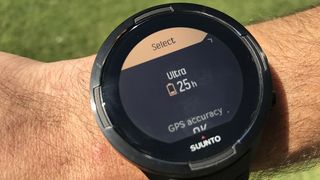
We’ll touch on the low-power mode accuracy a little later, but in terms of the battery life, we tested the Suunto 9 during a 100km multi-stage ultra. We took the watch off charge at 5.30am on a Friday, ran two 5-hour 50kms over a weekend and two midweek hour-long runs all on Performance mode.
The Suunto 9 finally ran out of battery the following Friday morning. That’s 7 days of normal usage with a good 12 hours of run time on the default battery setting.
We’re not quite fit enough to run for 120 hours to test the Ultra mode battery life – or even the 40-hour Endurance mode – to the full extent, but we did long runs in Ultra and Endurance mode to see what the battery drop was like. In Ultra mode we lost 4% in an hour. And in a three-hour-long test in Endurance mode we lost 16%.
So we’d suggest that the battery life does stand up strongly against those impressive claims. Unless you’re running the Barkley Marathons, this is a watch that will outlast you.
Battery life like this won’t just interest the mountain runners and Tour de France trainees either, this is a watch that regular runners and people training for a marathon can get a lot from too. Who doesn’t want a watch you can use to run all week on a single charge?
While we loved being able to easily switch power modes before and during runs to ensure we had enough juice to finish, we did experience what felt like a glitch with this, as we were often prompted to do that figure of eight faff to re-calibrate the compass when we changed between battery modes.
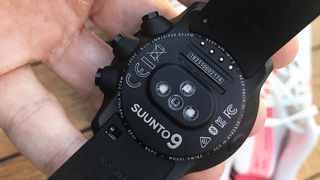
Features and tracking
- Tracks GPS and heart rate accurately
- Provides loads of post-session stats and insights
- Menu navigation can feel unintuitive
This is first and foremost a performance tool and as such you get the full suite of Suunto’s training tools, which includes guided interval training based on pace, time and heart rate.
The optical heart rate sensor powers zone training, 24/7 continuous heart rate tracking and heart rate-based calorie burn stats. You can, of course, pair a compatible Bluetooth chest strap for added accuracy during workouts.
We tested the Suunto up against a Polar H10 chest strap during our Dixons Carphone Race to the Stones Ultra and it performed well for wrist-based optical. The Suunto clocked us at an average 153BPM compared to the Polar H10 at 150BPM on day one, with the average heart rate for each mile split coming in 1-2 beats per minute lower. That’s a solid performance.

And what about the accuracy of those all-important GPS stats? We compared the Suunto 9 in Ultra mode (its lowest GPS settings) with the Garmin Forerunner 645 in full GPS mode (tracking GPS at one second intervals) over a 5km run with a few twists, turns and tunnels. And here’s what we found.
For total distance the Garmin clocked 3.30 miles against the Suunto’s 3.29. So nicely accurate there. As you can see from the maps, Suunto’s Ultra mode comes up pretty close to the Garmin. All round that’s impressive.

For those interested in running using power, Suunto plays nice with power meter shoe pods such as Stryd. Pairing Stryd is straightforward, though getting the power stats to appear on the watch involves firing up the Movescount web tools to create a custom sport mode. It’s quick enough to do but it’s a level of involvement that some might find frustrating.
Post-session you get a great array of performance stats on the watch with distance, pace, cadence, heart rate (including a color-code zone breakdown) and calories burned.
There are also some excellent recovery insights too with recovery time, EPOC (the oxygen required to restore your body to its normal, resting level of metabolic function) and a measure of your Peak Training Effect (PTE), an indication of the effectiveness of your training load from a single session.

The Suunto’s navigation skills are on point too, with real-time breadcrumb trails, point of interest navigation, route planning and finding, a personal route library that you can sync to your watch. One thing we couldn’t find though, was a way to run a route and then store it for navigation later.
Triathletes, Iron Man competitors and multi-sporters will enjoy the fact you can do a long press on the central button for quick transitions. While those whose pursuits are subject to altitude and air pressure will love that the Suunto 9 automatically switches between alto and barometer readings based on movements tracked on the accelerometer.
This means the Suunto can more accurately track changes in sea-level air pressure and altitude, so it’s better equipped for accuracy for sailing and hiking.
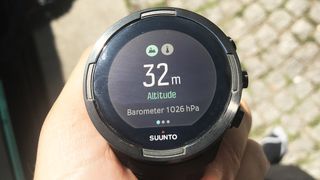
This watch isn’t just about hardcore performance, Suunto has done a good job of building in a good suite of general day-to-day health and fitness tracking features along with a touch of the smartwatch too.
Daily activity is tracked with steps and heart rate-based active and total calories burnt. You can set step count and calorie goals and a ring on the home screen charts your progress towards the target during the day.
A secondary ring on watch face also shows how you’re progressing towards a weekly training target that you can adjust on the Suunto app. One thing you don’t get that other watches offer are reminders to move more or suggestions on how you can reach your daily targets, so there are no hourly vibrations to remind you to get off your bottom.

Sleep tracking is catered for too. You can set your sleep times and track your sleep duration, waking time and your average heart rate during sleep. You can also adjust your Do Not Disturb hours to kill off pesky night time notifications. Though we do wonder, with a watch this size, if the only time you’ll want to wear this all night is when you’re up a mountain somewhere running a 30-hour ultra.
But we suspect Suunto 9 fans will be more the kind of people who want to forget the world and vanish into the wilderness, for those times when real life calls, once you’ve paired your Suunto 9 with your smartphone you can get notifications from your major apps. You can scroll back through historical updates too, which is a nice touch.
However, you can’t tailor which smartphone notifications sync to your Suunto 9. It’s all or nothing, or you have to switch them on and off using your phone’s app settings which obviously affects how they work even when you’re not using your Suunto.
When it comes to user interface design the Suunto 9 still suffers from the trademark menu and navigation inconsistencies, where you’re never 100% sure where each button press is going to land you. And frankly this is a product that you need to invest time learning rather than something that’s entirely intuitive out of the box.
Current page: Battery life, features and tracking
Prev Page Introduction, design and screen Next Page Apps, web tools, syncing and verdict